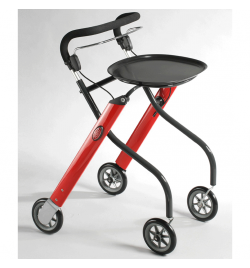Designing a flat for the elderly should be the same as designing for different types of impairments that elderly people may get together with older age. Designing a flat generally speaking for elderly people might include solutions that are not needed or miss some that are important.
A person that is 65 years of age is likely to have different needs compared to an elderly person that has reached the age of 90. Even so, not all people that have reached a specific age have the same needs and for this reason the flat has to be adapted and personalized according to the needs of the person that is about to use it.
Here follows a series of impairments that elderly people might have and possible solutions for them:
Visual impairment
I would equip the flat with a text reader, which transforms text into sound. This can be useful for situations when the glasses are not sufficient, but also for advanced cases of visual impairment.
Motoric impairment
For low motoric impairment needs I think it would be great to have voice recognition in the flat for light switch, for example. This should be present additionally to the classic light switch. Curtains could be shut and opened through the same method.
There should be no doorsteps.
A trolley together with a walker could help carry heavy objects around the flat. This is the example with the nicest design that I could find online:
If the person is using a wheelchair, then the height of different objects in the house should be lowered. The elderly person should place all kitchen tools, including plates and fridge at a level that is reachable. Carpets are removed and tiles are avoided, as they can be slippery. Voice recognition should be present for dialing emergency numbers in case of an accident.
Memory loss
A touch-based screen should display the schedule of that person in the room where she / he spends most time. Things to do or to remember should also be displayed.
Objects that are often lost should have a chip attached, which should make it possible to find through a map of the flat or through a vibrating devices that vibrates stronger when the person is closer to the lost object.
Last but not least
Social isolation
Connection to Skype and calling family and friends should be voice recognized.
A system picks up status updates and pictures that their grandchildren upload on Facebook, for example, but other social medias can also be included. They receive an announcement in real time when that happens, maybe on a touch-screen display that is positioned next to their favorite chair. The system strips the information from Facebook design and displays only pure text and images that the user can click on in order to browse.
The iPad is a tool that has been often used in activity centers for elderly people and seems to have a rather intuitive interface, so it might be a good platform. The grandchildren have, of course, the option of making a special group on Facebook where the grandparents will be placed so that they can’t access party pictures. It is their options as well to share this type of information with their grandparents, but such constant updates might be beneficial in the sense that the elderly people feel involved and updated in real-time.
This was my brief guess on how a flat for elderly persons could be equipped. Interviews and observation techniques could be used in order to identify if these solutions and needs are actually present for elderly people that have the listed type of impairments. Additional needs would certainly result from the research, leading to additional solutions as well.


